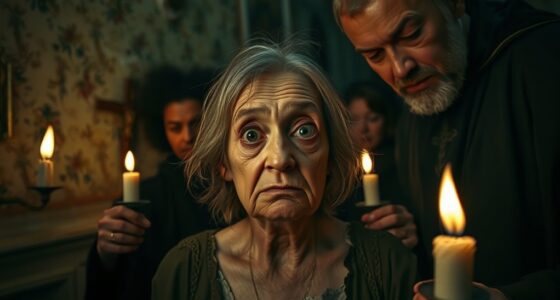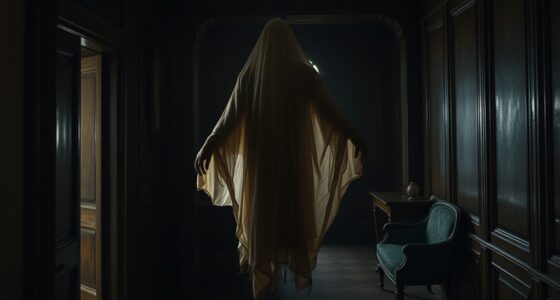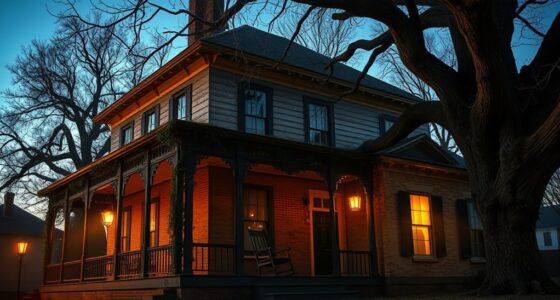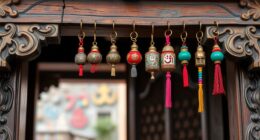Witnesses describe the Brown Lady of Raynham Hall as a translucent woman with flowing hair and a mournful expression, often seen drifting silently through the hallways. She typically appears on stormy nights or early mornings, and many report feeling sudden drops in temperature and a sense of sadness or unease when nearby. Photographs capture blurry, ghostly figures descending stairs, adding to her mysterious reputation. If you want to explore her eerie encounters further, there’s much more to uncover behind her haunting story.
Key Takeaways
- Witnesses report seeing a translucent woman in brown drifting through hallways, especially during stormy nights.
- Encounters include feelings of sadness, sudden temperature drops, and sensory experiences rather than always visual sightings.
- Photographs from the 1930s show a blurry, ghostly figure descending stairs, attributed to the Brown Lady.
- Sightings are often associated with her mournful expression, flowing hair, and her presence lingering in the hall.
- Reports have persisted for centuries, reinforcing her reputation as Raynham Hall’s enduring spectral resident.

The Brown Lady of Raynham Hall is one of the most famous ghost stories in England, known for its eerie sightings and mysterious origins. Over the years, numerous witnesses have reported haunting encounters that keep this story alive. If you’re interested in ghost sightings and historical hauntings, the Brown Lady’s tale offers a chilling glimpse into the supernatural. Many who have visited Raynham Hall claim to have seen a ghostly figure dressed in brown, often drifting through the corridors or appearing in photographs. These sightings aren’t isolated; they form part of a long-standing pattern of spectral encounters that have persisted for centuries. People have described seeing a translucent woman with flowing hair and a mournful expression, her presence felt more than seen. Some witnesses report feeling a sudden drop in temperature or an overwhelming sense of sadness when the apparition appears. Others have snapped photographs, only to find a blurry, ghostly figure materializing in the images — a phenomenon that has fueled her reputation. The sightings are closely tied to the hall’s history, making it a significant example of historical hauntings, which often involve spirits connected to past events or tragedies. Rumors suggest that the Brown Lady is the spirit of Lady Dorothy Walpole, who was imprisoned in Raynham Hall in the early 18th century after her husband’s death. Her tragic story adds a layer of sorrow and mystery to her appearances, which many believe are a manifestation of her restless spirit. The haunting is deeply rooted in the hall’s history, and visitors often report feeling an unsettling presence when exploring the estate. The ghost’s frequent appearances during stormy nights and in the early hours add to the legend, making it a staple of British ghost lore. Photographs taken in the 1930s, especially the famous image captured by Captain Hubert C. Provand and Indre Shira, have cemented her place in paranormal history. The image shows a hazy, flowing figure descending the staircase, and it’s widely regarded as one of the most convincing ghost photos ever taken. If you’re drawn to ghost sightings and historical hauntings, Raynham Hall’s story offers a compelling, eerie narrative. The consistent reports and documented sightings over centuries continue to intrigue skeptics and believers alike. The Brown Lady’s ghostly presence remains a haunting reminder of the hall’s turbulent past and the enduring power of spectral legends in England. Her story, woven into the fabric of Raynham Hall’s history, invites you to explore the mysteries lurking within its ancient walls.
Frequently Asked Questions
Has Anyone Ever Captured a Clear Photograph of the Brown Lady?
You might find it surprising, but no one has captured a truly clear photograph of the Brown Lady that’s widely accepted as authentic ghost photography. Many images exist, but questions about photographic authenticity persist, making it difficult to confirm any clear, definitive shot. The elusive nature of the Brown Lady continues to fuel skepticism and fascination, leaving skeptics and believers alike searching for that one perfect, credible image.
What Is the History Behind the Brown Lady’s Appearance?
You might find it fascinating that the Brown Lady’s appearance stems from a ghost legend rooted in historical context. She’s believed to be Lady Dorothy Walpole, who died in 1726, and her spirit is said to haunt Raynham Hall. Her ghostly image has become famous due to the legendary photo, fueling stories that blend history and supernatural lore. This background makes her a compelling figure in ghost stories and British haunted history.
Are There Any Documented Sightings From Before the 20TH Century?
You’ll find that historical accounts and pre-20th century sightings of the Brown Lady are scarce, like whispers lost in time. Some reports hint at ghostly encounters dating back to the 18th century, when the hall’s history was still shrouded in mystery. These early sightings symbolize the enduring allure of the unknown, suggesting that her presence has haunted the estate long before modern reports brought her legend to light.
How Do Skeptics Explain the Brown Lady Phenomenon?
Skeptics attribute the Brown Lady phenomenon to paranormal skepticism, suggesting it’s not a ghost but an optical illusion. They point out that lighting conditions, reflections, or camera effects can create ghostly images. You might notice how shadows and movement can trick your eyes, making it seem like a mysterious figure. By understanding these natural causes, skeptics argue the Brown Lady’s sightings are explainable and not supernatural at all.
Has the Brown Lady Ever Been Linked to Any Specific Tragic Event?
The Brown Lady has been linked to a tragic event involving Lady Dorothy Walpole, who supposedly died of smallpox or heartbreak in the early 18th century. Regarding historical context, her story fuels paranormal theories, suggesting her restless spirit haunts Raynham Hall. Some believe she appears seeking closure, while skeptics argue it’s merely a ghostly legend. Either way, her tale shows that history and mystery often walk hand in hand.
Conclusion
As you step back from the tales of the Brown Lady, it’s like gazing into a mist-shrouded mirror reflecting whispers of the past. Witnesses’ stories paint her as a ghostly whisper drifting through time’s fog, a haunting echo etched into the walls of Raynham Hall. Whether real or imagined, she remains a spectral thread woven into history’s tapestry, a ghostly silhouette dancing just beyond your reach, forever caught between the worlds of the living and the departed.








